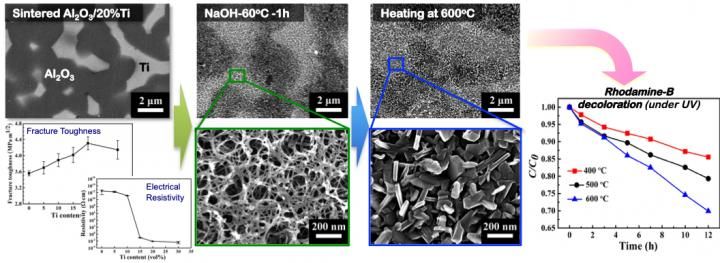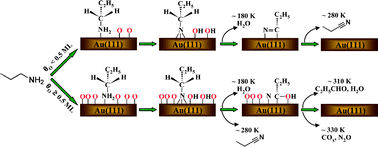Multifunctional dream ceramic matrix composites are born!
Ceramic matrix composites exhibit electrical conductivity and photocatalytic activity
Researchers at Osaka University produced composites consisting of alumina (AI2O3) ceramics and titanium (Ti), namely AI2O3/Ti composites. They designed a percolation structure for forming a continuous conduction pathway by dispersing fine-sized Ti particles into an AI2O3 matrix, optimizing the particle size of metallic Ti powder and sintering processes. They improved fracture toughness and electrical conductivity of AI2O3/Ti composites while simultaneously giving them photocatalytic ability through chemical and/or thermal treatment.

(Upper left) This is a structure of Ti-dispersed AI2O3 composites (Lower left) Ti content dependency of fracture roughness and electrical resistivity (Middle) Nanostructure of the surface of AI2O3 composites produced via chemical and heat treatments (Right) Discolored by the photocatalytic activity of AI2O3 composites after chemical and heat treatments.
Osaka University
Various types of metal-ceramic composites have been researched and developed, but their combination and fine structures were limited. In particular, the combination of ceramics such as alumina used as matrices and titanium, a biocompatible metal, has a problem in that the structure of composites is not uniform because of the high reactivity of titanium (oxidation happens and chemical compounds are produced) and the large particle size of commercially-available Ti powder (several tens of micrometers). Thus, it was difficult to produce composites that have advantages of both ceramics and metal: that is, composites in which metallic Ti powder is homogeneously dispersed in the matrix and has excellent mechanical properties.
The group prepared ball-milled titanium hydride (TiH2) fine powder mixed with alumina powder, producing AI2O3/Ti composites using a method based on the in situ decomposition of TiH2 to Ti and simultaneous sintering with Al2O3, which process inhibited AI2O3 dissolution into Ti by diffusion through interfacial reaction between AI2O3 and Ti during sintering. As a result, they minimized reactivity of Ti and AI2O3 to disperse significantly finer and more homogeneous Ti (compared to those produced with conventional methods) in AI2O3, realizing composites with a percolation structure by controlling the content of added Ti.
In this way, the group improved fracture toughness of inherently brittle AI2O3 through dispersion of fine Ti particles into AI2O3 and, due to percolation of metallic Ti particles, contributing electrical conductivity to insulator ceramics AI2O3. They also demonstrated that AI2O3 ceramics could be machined by electrical discharge machining like metals. (Usually, ceramics are not electrically conductive.) In addition, they formed a nano-porous- or nanorod- structured titania layer on the surface of the composite by selectively oxidizing Ti via NaOH treatment and/or heat treatment. Through this, they demonstrated that the photocatalytic ability to break down organic substances could also simultaneously be given to AI2O3/Ti composites.
Group leader Tohru Sekino says, "AI2O3/Ti composites will be used as ceramic matrix composites that have excellent mechanical properties and can be machined by electrical discharge machining. They will also be used for industrial products and biomaterials as new multi-functional composites that have an active surface layer with antibacterial properties and a photocatalytic ability to break down pollutants."
Original publication
Original publication
Shengfang SHI and Tomoyo GOTO and Sung Hun CHO and Tohru SEKINO; "Surface-morphology modification of ceramic-based composites for photocatalytic activity via simple chemical and heat treatments"; Journal of the Ceramic Society of Japan; 2018
Topics
Organizations
Other news from the department science

Get the chemical industry in your inbox
By submitting this form you agree that LUMITOS AG will send you the newsletter(s) selected above by email. Your data will not be passed on to third parties. Your data will be stored and processed in accordance with our data protection regulations. LUMITOS may contact you by email for the purpose of advertising or market and opinion surveys. You can revoke your consent at any time without giving reasons to LUMITOS AG, Ernst-Augustin-Str. 2, 12489 Berlin, Germany or by e-mail at revoke@lumitos.com with effect for the future. In addition, each email contains a link to unsubscribe from the corresponding newsletter.



























































